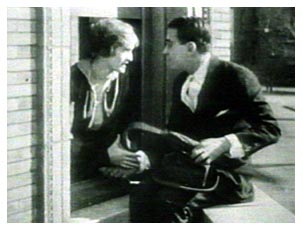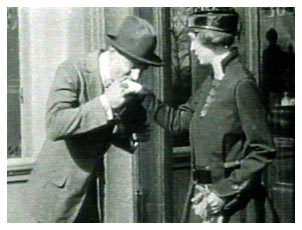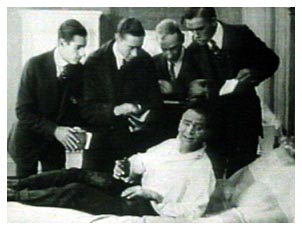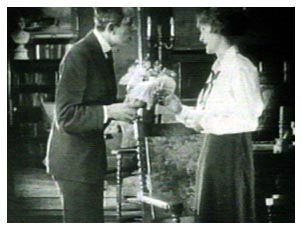

Triangle Film Corporation
CAST: Douglas Fairbanks (Pete Prindle), Loretta Blake (Christine
Cadwalader), Clarence Handyside (Proteus Prindle), Charles Butler
(Cassius Cadwalader), Rene Boucicault (Pansy Prindle), Jean Temple
(Pearl Prindle), Homer Hunt (Melville)
Pete Prindle is the son of a wealthy businessman, Proteus
Prindle - manufacturer of the healthy Prindle's 27 Vegetarian
Varieties. The only problem is that Pete prefers meat, and, although
he works for his father, he takes little interest in his father's
business . . . or eating habits. He prefers meat with his meals,
an active lifestyle, loves boxing, and hates sitting at a desk
all day. He meets and falls in love with pretty Christine Cadwalader.
She is the daughter of railroad magnate Cassius Cadwalader, who
is also a vegetarian and a business associate of Pete's father.
When Pete proposes to Christine, Cadwalader refuses to give his
daughter's hand in marriage until Pete owns half interest in Prindle's
empire. Unfortunately, Pete is in "Dutch" with his father,
too. His two overweight sisters appeared in an article in Vegetarian
Gazette promoting Prindle's products - "What have you
done to promote Prindle's products?" his father demands,
and orders him to get out until he makes good. So, to prove he
can do what his sisters have done - but better -- Pete sets out
to get his photo in all of the newspapers in New York. However,
a fake car accident, beating a champion boxer, swimming to shore
from a steamer and getting thrown in jail only get him brief mentions
in the newspaper. In the meantime, Cadwalader is being threatened
with death by a criminal gang known as the Weazels unless he meets
their extortion demands. After a failed attempt to kill Cadwalader
by stabbing him, they devise a plan for a train to wreck on which
 Cadwalader is riding. Pete happens
upon the gangsters' plot, defeats them single-handedly and saves
the train. As a result, he is hailed as a national hero in all
of the newspapers.
Cadwalader is riding. Pete happens
upon the gangsters' plot, defeats them single-handedly and saves
the train. As a result, he is hailed as a national hero in all
of the newspapers.
"His Picture in the Papers" was Fairbanks third feature and the first in which we see the Fairbanks that the public came to love so well throughout the rest of the silent era. As biographer Booten Herndon pointed out in The Most Popular Couple the World Has Known: Mary Pickford and Douglas Fairbanks (W.W. Norton & Company, Inc., 1977), "Thus in three films, one ('The Lamb') a hodgepodge providing an exercise in filmmaking, the second ('Double Trouble') a lesson in what not to do, the third the realization and implementation of the successful formula, Douglas Fairbanks established his screen character." The exuberant character comes through well in this feature; the go-getter who will not be discouraged and can overcome anything; the acrobat who, just for the fun of it, leaps over furniture and climbs the outside wall of his beloved's house to her window. As with virtually all of his 28 films leading up to "The Mark of Zorro" in 1920, it was Doug's personality that made the films, not the storylines.
Herndon went on to say, "'His Picture in the Papers' made an impact on both Fairbanks and the cinema in that it was designed for the player. The character Fairbanks played was about 90 percent Fairbanks. Not only does his athletic ability stand out, but more important, so does his natural charm. When a beat-up old nag he finds in a barnyard delivers him to his destination in the nick of time, for example, he gives the horse a big kiss. Whether the idea was his, John Emerson's or Anita Loos', it was one of several little touches that enhanced his appeal and helped establish him firmly as a popular comedian."
Of course, Fairbanks never received any accolades for his acting ability. A thorough review of all of his extant films will show no outstanding dramatic portrayal or one-of-a-kind characterization. But the personality is there with an appeal that came from an explicable charisma, a charm, his athleticism, his movie-making skills, and his exuberant persona. As for the acting, respected silent movie historian Edward Wageknecht said in his book The Movies in the Age of Innocence (University of Oklahoma Press, 1962), "Fairbanks was not really a good actor; in the proper sense of the term he was hardly an actor at all. Even in his most ambitious days - in 'Robin Hood,' for example - he would cleverly turn away from the camera or cover his face with his hands as a substitute for expressing emotion. On the other hand, his feeling for rhythm and movement was flawless, and he was ideally adapted to the film medium."
The Fairbanks charm was combined with the husband-wife team of John Emerson, who directed, and Anita Loos, who wrote the screenplays, to provide a movie-watching experience that was a sure-fire success at the box office. It was with "His Picture in the Papers" that the trio finally hit their stride.
Most of the story fodder came from fads of the day, and
the formula for success called for a satirizing of these fads.
In the mid-teens, social tidbits were a common occurrence in the
newspaper, and, of course, if you were important enough, instead
of just a few lines, you may get your picture in the paper, as
well. Loos took this and built a story around it complete with
romance, the  search for success in the business
world, health foods (another fad), gangsters, and family strife
- all within a humorous - and some may say silly - context.
search for success in the business
world, health foods (another fad), gangsters, and family strife
- all within a humorous - and some may say silly - context.
Surprisingly, there is no "boy wins girl, boys loses girl, boys wins girl back" subplot to the story. Pete meets Christine at his house one evening when Proteus Prindle has Cassius Cadwalader and his beautiful daughter over for a dinner party. Of course, the meal consists solely of health food for the vegetarian crowd, so, after dinner, Pete heads for a nearby restaurant for some real food . . . with meat! He is surprised to see Christine come into the restaurant with the same idea, and the two enjoy a romantic meal together.
A very well-done scene shows Peter at his desk, unable to work for thinking about Christine. We then see Christine playing piano at her home, stopping and then taking a deep sigh - a tried and true way, through pantomime, to let the viewer know she is in love - and then a fade back to Pete. Enough is enough. His mind is made up. The intertitle tells us, "And flying to Christine's side, he asks her to join him for life on a good, strong meat diet." Of course, she accepts, but in comes father Cadwalader who protests, "You're no true son of Prindle. Get a half interest in your father's business, and then I'll consent. Meantime, stay away from my house."
Not only does he incur the wrath of Christine's father, he returns to work to bear the wrath of his father, as well. Already angry that Pete left the office without completing his work, his father points out that sisters Pansy and Pearl got their pictures published in the Vegetarian Gazette promoting Prindle's products and demands to know what Pete has done to promote the business. Pete scoffs at his sisters' publicity saying he can get his picture in every paper in New York if he wanted to. At that, his father tells him to get out until he has made good, and thus is the foundation laid for the remainder of the film - and a series of comic misadventures.
Fairbanks' humor was somewhat unique for the period - no slapstick (at least of the Keystone type), no bellylaughs - but instead humor that comes about from situations, probably more akin to the Mr. and Mrs. Sidney Drew or John Bunny comedies that were popular in these early years of the cinema. For example, he buys a car, pushes it off a cliff, goes down to the wreck and stretches himself out as an accident victim. A good Samaritan comes by and takes him to the hospital. Reporters fill the room, and he hands them photos of himself to use with their news stories. The next day, the only mention of him is a brief line buried inside the paper among other traffic accident victims.
A very humorous episode occurs when he asks a buddy to loan him some money to see Vera Carewes. He doesn't mention that Vera Carewes is a fortune teller, and his buddy mistakenly thinks he meant Vera Cruz. Deciding to stay and have a drink with the boys before leaving, Pete ends up having one too many and passes out. The next morning, he finds himself on a steamer headed for Vera Cruz - the result of a well-intentioned friend who was trying to help him get to "Vera Cruz!" Not far off the coast of Atlantic City, Pete jumps overboard and swims to shore. Since he's in his pajamas, the police arrest him, but not without a battle from the feisty Pete in front of all the beach-goers. The episode is OK with Pete, because he will finally get his name in the paper. The next day the newspaper reports the incident, but the name has been "withheld due to the imminent respectability of the family." Once again he has failed to get his picture in the papers.
Learning that the boxing champ is taking on all comers,
Pete figures this is a sure way to get his name in the papers.
He defeats the champ, but just as the photographers are taking
photos, the place is raided by the police, and Pete barely escapes.
No publicity!
The fight scene was filmed at the Sharkey Athletic Club in New York. Emerson and Fairbanks were members of the Lambs and Friars clubs and persuaded their fellow members, as well as a number of fight fans, to fill the arena. The large number of people - who seem to be enjoying themselves and carrying on as a rowdy crowd would at such an event in those days - gives the scene a sense of realism.
Loos had a knack for weaving in a subplot to Fairbanks' films that seemed to have no bearing on the main plot of the story but, in the end, was integral to the resolution of the main conflict. We have been exposed several times during the story to a gang of criminals called the "Weazels." They threaten Cadwalader in an effort to extort money from him; however, he decides to fight back. Working in conjunction with the police, he succeeds in getting one of the gang arrested as he tries to pick up the extortion money in Central Park. Angry, the gang decides to go through with their death threat. In the hallway of his office, a gang member stabs Cadwalader and runs away. Although severely shaken, Cadwalader was saved by a box of Prindle's Lifesaving Lentils that he had in his inside coat pocket.
Later, the gang learns that Prindle is taking a trip on the train to Philadelphia. They make plans to turn the track switch along the way so Prindle's train crashes into another parked train car at one point on the journey. Pete, walking along the track, broke, dejected and exasperated after his failed attempt to gain publicity from the boxing match, encounters the gangsters planning their dirty deed. Of course, this is where we get to see some of that famous Fairbanks athleticism as he fights and defeats the whole gang - then, tired, badly battered and hardly able to crawl across the ground, he barely reaches the switch in the knick of time to keep the train on the right track. Of course, this heroic deed is just what he needed to get his picture in the papers.
The other members of the cast are forgotten names. Loretta Blake, who played the female lead, is a virtual unknown today and was never a star of significance. She only made a handful of films from 1914 to 1920, and seems to be of those "lost players" about whom little or nothing is known. Billy Doyle's The Ultimate Directory of the Silent Screen Performers: A Necrology of Births and Deaths and Essays on 50 Lost Players" (Scarecrow Press, Inc., 1995) doesn't mention her. The Internet Movie Database does give a date of death as 1964 but not date of birth. Variety Obits does not mention her, either. Her role in this film is of such insignificance, it's difficult to tell what talent she may have possessed. She's fairly attractive, but she's in very few scenes, and then only to act shy and demure against Fairbanks' love-making.
Clarence Handyside, who plays Proteus Prindle, was born in 1854 and died in 1931. "His Picture in the Papers" was one of 13 feature films he made between 1914 and 1918 (according to the American Film Institute Catalog). His one appearance with Fairbanks appears to have been the highlight of his career. He performs the part of Pete's blustery, exasperated father to satisfaction.
Christine's father is played by Charles Butler who stands
- at a very short height - in obvious constrast to
Handyside who was a man of better than average size - both in
height and girth. Butler was born in 1856 and died just five years
after making this film. The AFI Catalog only lists two
other films for Butler in addition to "His Picture,"
and one of those is uncertain if it is the same Charles Butler.
He, too, does a satisfactory job as the stern father who protects
his daughter and fights back when threatened by extortionists.
 Filming for "His Picture in
the Papers" began October 4, 1915, and it was released in
February of 1916. At that time, Fairbanks had agreed on terms
for a three-year contract with Triangle which called for a salary
of $2,000 per week with a $500 per week increase every six months.
Because he was reluctant to leave New York entirely, he would
alternate between making pictures in New York and Hollywood."
Filming for "His Picture in
the Papers" began October 4, 1915, and it was released in
February of 1916. At that time, Fairbanks had agreed on terms
for a three-year contract with Triangle which called for a salary
of $2,000 per week with a $500 per week increase every six months.
Because he was reluctant to leave New York entirely, he would
alternate between making pictures in New York and Hollywood."
Fairbanks was a stage star at the top of his game when he went into pictures. According to biographers Ralph Hancock and Letitia Fairbanks (Douglas Fairbanks, The Fourth Musketeer, Henry Holt and Company, Inc., 1953), ". . . during the shooting Fairbanks was approached by Sam Shubert with a proposition to return to the stage. But Douglas had just signed the new contract doubling his salary, and nothing Shubert could offer him was attractive by comparison. It was perhaps his last opportunity to return to the stage. Money, one might say, was talking louder than art, but there was more to it than that. Douglas had found his element, and it is doubtful if he would have returned to the theater at this time even if the offer had equaled his new contract."
Fairbanks admired the films of D.W. Griffith, and one of the reasons he was wooed away from the stage was that his films would be supervised by Griffith. However, the great director was not a fan of Fairbanks' films and suggested that "His Picture in the Papers" should be cut down to a two-reeler. The film was shelved, but, according to Richard Schickel in his book, His Picture in the Papers: A Speculation on Celebrity in America Base on the Life of Douglas Fairbanks, Sr. (Charterhouse, 1973), " . . . a print was somehow shipped to New York anyway and, in turn, it was sent over to Roxy Rothafel at the Strand Theatre as a substitute for a picture he had booked but which had gotten lost in transit. By the end of the first reel of 'His Picture,' the theater, according to Miss Loos, 'was fairly rocking with laughter.' By the next day, The New York Times had proclaimed it a hit, and Roxy, of course, kept it on."
There are no doubt better films from this period in Fairbanks' career since he progressively learned more about the medium and audience tastes and improved with each successive effort. The basic components varied little from picture to picture, but the formula for success was made, and it appeared that Fairbanks was not anxious to dawdle with a good thing. Actually, when he made "The Mark of Zorro" in 1920, which sent his career in an entirely different direction, he assumed he was making a one-time change and would return to his tried and true methods - which is exactly what he did by making "The Nut" (1921) after the completion of "Zorro." However, there was no denying the unexpected success of "Zorro," and his course was charted for the rest of the silent era.
As popular as "The Mark of Zorro," "The Three Musketeers" (1921), "Robin Hood" (1922), "The Black Pirate" (1926) and his other adventure films of the 1920's are, it's still a delight to go back once in awhile and watch the early Doug in action. "His Picture in the Papers" still gives us that same broad smile and a goodly dose of acrobatics just like the "big" pictures of later years, but in a simpler, more charming way.
Copyright 2007 by Tim Lussier. All rights reserved.